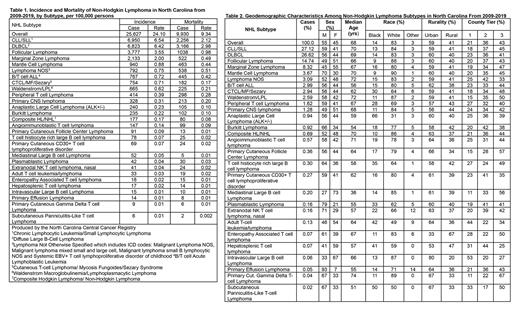Abstract
Background: Non-Hodgkin lymphoma (NHL) is the most common hematologic malignancy in the United States. NHL comprises a heterogeneous group of over 40 histological subtypes, each of which has distinct genetic, morphologic and clinical features. While NHL epidemiology as a single entity has been well-characterized using population-based cancer registry data, the epidemiology of NHL subtypes is not well understood and even less data are available for rarer subtypes. We aimed to determine geodemographic correlates for NHL subtypes in North Carolina to provide rarely reported epidemiologic characterization of each distinct malignancy.
Methods: Demographic data were obtained on all NHL subtypes reported in persons >18 years of age from 2009-2019 from the North Carolina Central Cancer Registry (NCCCR). NHL subtypes were determined based on World Health Organization International Classification of Diseases for Oncology,Third Edition (ICD-O-3) Morphology codes provided by NCCCR. Crude incidence and mortality rates were estimated per 100,000 persons for the 10-year period using 2019 population data from the U.S Census Bureau. Urban and rural residence designations were based on zip code using rural-urban commuting codes developed by the Rural Health Research Center. County tier designations were used as markers of economic prosperity, with 3 being most prosperous, and provided by the North Carolina Department of Commerce. Data are being mapped using ESRI ArcMap 10.8.1.
Results: A total of 25,627 incident cases of NHL and 9,930 associated deaths were reported between 2009 and 2019 in North Carolina. Therefore, the standard NHL incidence and mortality rates are 24.1 and 9.3 per 100,000 persons. For incident NHL cases, median age at diagnosis was 68 years (range 19-103), 55% were male and 45% female. Most (83%) identified as white, 14% as black, and 3% as other. Median age at death was 70 years (range 19-106). Twenty-eight NHL subtypes were identified with the four most common NHL subtypes being Chronic Lymphocytic Leukemia/Small Lymphocytic Lymphoma (CLL/SLL), Diffuse Large B Cell Lymphoma (DLBCL), Follicular Lymphoma (FL), and Marginal Zone Lymphoma with 6.54, 6.42, 3.55, and 2.0 cases (per 100,000 persons), respectively. Least common subtypes included Intravascular Large B Cell Lymphoma, Primary Effusion Lymphoma, Primary Cutaneous Gamma Delta T-cell Lymphoma (PCGD-TCL) and Subcutaneous Panniculitis-Like T-cell Lymphoma, all with 0.01 cases per 100,000 persons (or 15, 14, 9 and 6 cases respectively). The distribution of NHL subtypes varied according to demographics with several notable findings. DLBCL had the highest crude mortality rate of 2.98 deaths/100,000 persons, followed by CLL (2.12 deaths/100,000 persons), FL (0.98 deaths/100,000 persons) and Lymphoma NOS (0.51 deaths/100,00 persons). Mediastinal Large B-cell Lymphoma (MLBCL) was diagnosed in the youngest individuals with median age of 36 (range 20-74), whereas PCGD-TCL occurred in the oldest with median age of 74 (range 31-99). Primary Effusion Lymphoma had the highest male predominance (93%) and MLBCL had the highest female predominance (73%). Mantle Cell Lymphoma had the highest predominance of persons who identify as white (90%), Anaplastic Large Cell Lymphoma (ALK+/-) with those who identify as black (66%), and Primary Effusion Lymphoma with those who identify as other (14%). Predominance of rurality and county tier designations varied by NHL subtype.
Conclusions: A registry-based assessment of NHL subtypes illustrates the heterogeneous nature of this group of malignancies and highlights significant variation in the geodemographic features of each subtype. Evaluating geodemographic correlates deepens our understanding of NHL subtypes and can inform populations at risk for each unique NHL subtype.
Dittus: BeiGene: Other: Advisory Board; Seattle Genetics: Research Funding; AstraZeneca: Research Funding; Genentech: Research Funding.


This feature is available to Subscribers Only
Sign In or Create an Account Close Modal